Low-fuming technologies make for safe shops at reasonable costs. Many shops believe that meeting today’s workplace-exposure standards can negatively impact their bottom line. But that’s not necessarily true. In fact, shops using the right combination of low-fuming -electrode technology, argon-based shielding gases, and pulsed-gas-metal arc-welding (GMAW) power supplies can create a safe working environment while increasing productivity and lowering operational costs.
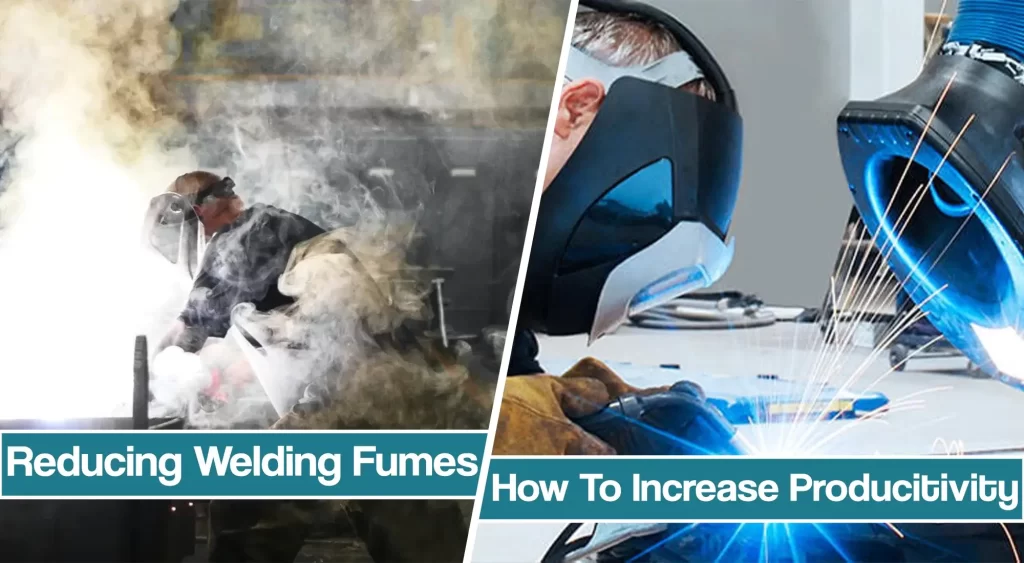
Recently, the American Conference of Governmental Industrial Hygienists (ACGIH) put forth strict exposure guidelines, or threshold-limit-values (TLVs), for manganese, nickel, and hexavalent chromium. In this article, we will discuss reducing welding fumes to increase productivity.
Reducing Welding Fumes To Increase Productivity -Adhering To Exposure Standards
While the exposure limit for welding fume — 5 mg/m3 — hasn’t changed, exposure limits are lower for some standard welding-fume components, such as the manganese and chromium compounds in carbon and stainless steel welding fume.
In 1995, ACGIH reduced allowable exposure to manganese from 1 to 0.2 mg/m 3. Because manganese is 5-15% of a typical welding fume from plain carbon steel electrodes, for acceptable exposure levels, companies must limit their fume levels to 2-3 mg/m 3 .
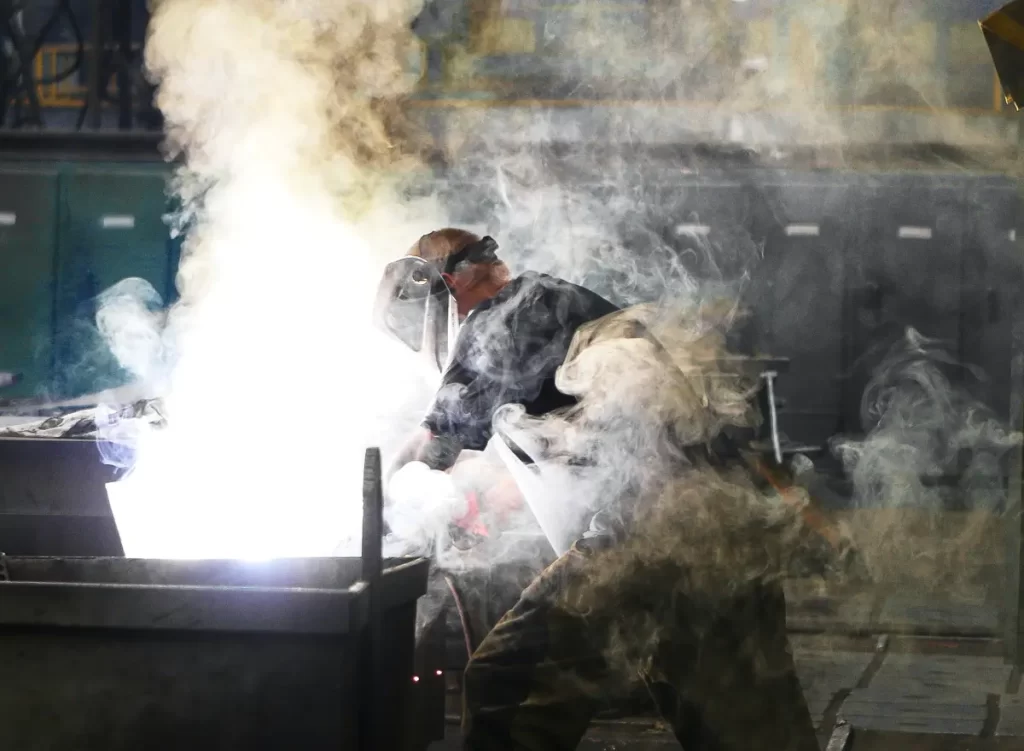
ACGIH also tightened exposure limits for hexavalent chromium. This, and the current debate within the Occupational Safety and Health Administration (OSHA), which may result in even-lower allowable hexavalent exposures than those advocated by ACGIH, has focused industry attention on controlling worker exposure to stainless steel welding fume. Existing and proposed exposure limits call for workers at some companies to wear special respiratory protection when welding with stainless steel consumables.
Shops can best adhere to regulatory limits by carefully selecting optimal consumables and processes and providing adequate ventilation.
Creating The Welding Fume
In the welding process, as the consumable electrode melts and vaporizes, fume, or solid particulate, rises in a plume from the arc. About 90-95% of fume comes from the electrode, with the remainder coming from the base material.
Welding fume is fully respirable, consisting of 0.01-1.0 µ diameter particles, chemically complex spheres typically fused as chains or clusters.
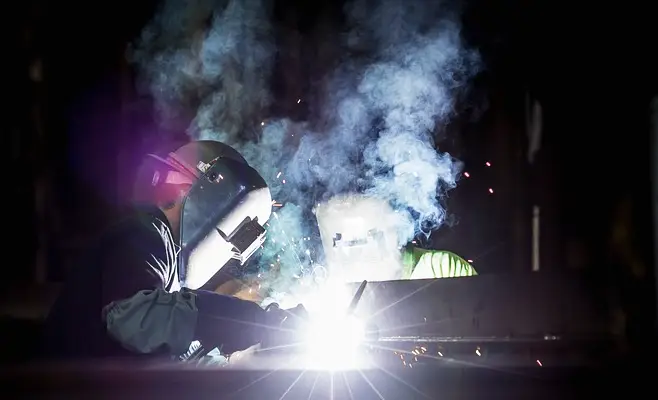
The chemical composition of fume is similar to that of the electrode; however, fume elements such as manganese and copper are enriched beyond those in the electrode. Despite its complex chemistry, exposure limits for individual elements or pure oxides apply to the welding fume.
In addition to the solid particulate, gases including carbon monoxide, nitrogen oxides (NO and NO2), and ozone also arise within the arc environment. Carbon dioxide, often present as a shielding-gas component or a byproduct of components found in flux-bearing consumables (shielded-metal arc electrodes and flux-cored wires), decomposes and forms carbon monoxide. The thermal decomposition of nitrogen generates nitrogen oxides, with the highest quantities near plasma-cutting processes using nitrogen as a process gas. Carbon monoxide and oxides of nitrogen usually stay within the fume plume.
Ozone comes from the interaction of a specific wavelength range of ultraviolet light with oxygen both within and outside the arc zone. The ultraviolet light is present near arcs shielded with argon-based gases, and also originates when silicon vaporizes in the arc environment. The largest quantities of ozone are generated in argon-shielded aluminum welding with 4000 series consumables such as 4043.
Analyzing Welding Fume Variables
Welding voltage and current affect fume generation. Power applied to the electrode determines the length of a welding arc. As voltage increases, the arc length, or the distance that metal droplets from the electrode travel before reaching the weld puddle, also increases.
The resulting long arc path extends the amount of time the droplet at the end of the electrode has to “boil” and emit a fume.
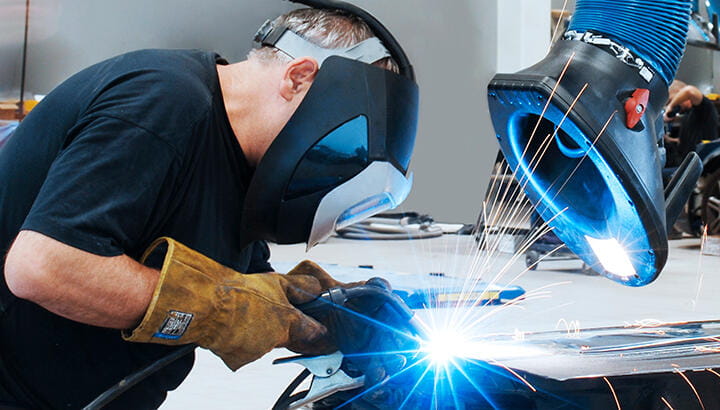
The amount of material melted is proportional to the welding current and influences the type of metal transfer that occurs. As current increases, fume levels increase as well. As the current level rises in solid-wire MIG, a metal transfer may change depending on the shielding gas used. Metal transfer changes from short-circuiting to globular to fine-droplet spray as the electrode current increases, degrading arc stability. This, in turn, influences the fume created.
For gas-shielded processes, the reactivity of the gas blend and the metal transfer influence fume levels. High percentages (> 80 %) of argon allow for a stable, fine-droplet transfer with moderate currents. With these moderate currents, transfer remains globular when shielding gases contain more than 20-25% carbon dioxide. As the percentage of carbon dioxide in the shielding gas increases, so does the amount of welding fume, true for solid and metal-cored wires.
With flux and metal-cored wires, the compositions of the core material and strips influence fume generation. For example, the strip’s high-volatility components and high carbon content increase fume. As with current variations, changes in the amounts of these components influence arc stability and, thus, fume amounts. However, recent advances in manufacturing technology and new formulations have created a new group of low-fume generation flux and metal-cored wires.
Reducing Worker Exposure
Even with a handle on variables such as current and voltage and process and consumables selection, companies often find it challenging to accurately predict worker exposure because so much depends on differences among individual welders. For example, the closer the welder’s breathing zone (defined as the area within about 9 in. of the nose and mouth to the plume), the higher the exposure. Also, personal welding habits, the position of the work concerning the welder, type of weld to be completed, and style of protective equipment worn all influence welder exposure levels.
Despite these challenges, common sense dictates that the most effective way to reduce worker exposure is to limit the amount of fume generated. Recommendations include:
- Change the welder’s work habits, for example, by repositioning the workpiece to remove the breathing zone from the vicinity of the fume plume.
- Improve ventilation and exhaust at the arc.
- Choose the best welding process.
- Use low-fume consumables and shielding gases.
Choosing Low-fume Consumables
Shops can use various welding processes to achieve a specific metal-deposition rate. As a result, different amounts of welding fume are created depending on the method and consumables selected. For example, using solid wire with argon-based shielding gases in fine-droplet-spray transfer gives one of the lowest levels of fume per amount of weld metal deposited.
In addition, the industry drives to reduce worker exposure while increasing productivity and lowering costs, has led to the development of new low-fume consumables, such as flux-cored and metal-cored wires.
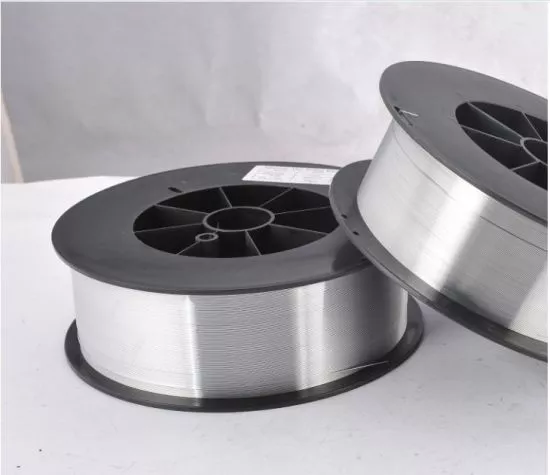
Older-design flux-cored wires, especially with larger diameters (> 2.0 mm), were formulated to operate in 100% CO2 shielding. These wires generate substantial amounts of welding fume.
Welding with the new-generation wires reduces fume levels because the wires use low-carbon strip materials for the tube and less of the mineral compounds causing high fume levels.
With a carefully balanced core chemistry, low-fume flux-cored wires work in gas blends with argon content as high as 95%. In addition, using these wires substantially reduces fume amounts, approaching those of solid wire.
The newly formulated metal-cored wires also reduce fume levels. Flux-cored and metal-cored wires, with their optimized formulations, show excellent operating qualities while reducing fume exposure. However, because the performance of these wires varies, shops need to weigh combinations suitable for their applications carefully.
Picking new process technology
Inverter-power-supply technology and its application to pulsed-metal transfer also show great potential for reducing welding fume. This is because the rapid “cur-rent rise” times and the high pulsing frequency allow metal droplets formed at the tip of the wire electrode to quickly detach, minimizing time spent “fuming” at the wire tip.
Older pulse technology, in which rise times are slower and droplets less frequently detached, leads to slightly higher fume levels than new pulse technology, but still less than conventional fine-droplet spray.
Testing New Process Technology
Shops using metal-cored wires instead of large-diameter (> 2.0 mm) flux-cored wires shielded with 100% carbon dioxide demonstrate how to enhance welding productivity and worker safety while reducing welding costs. For example, a manufacturer of stone crushing equipment had been using about 50,000 kg/year of 1.6 mm and 2.4-mm flux-cored wire with 100% CO2 shielding. He replaced the flux-cored wires with a 1.6-mm metal-cored wire and used 10 Ar-10 CO2 shieldings, which improved deposition rate and efficiency and reduced fume. As a result, the shop achieved the following:
- Deposition efficiency (average):
- Flux-cored wires: 80-86%
- Metal-cored wires: 93-97%
- Current deposition rate:
- Flux-cored wires (average): 5 kg/hr at 350 amp
- Metal-cored wires: 6.8 kg/hr at 350 amp
- Fume-generation rates:
- Flux-cored wires: 1,500-2,000 mg/min
- Low-fume Metal-cored wires: 500-1,000 mg/min
Comparing costs, the original method costs $9.75/m of weld against $6.96/m of weld for the metal-cored wire, showing that costs can be reduced and productivity increased, while reducing welding fume.





